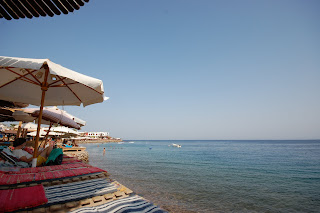One week in N. Africa complete, 19 more weeks left. I am sure the time spent here will pass by quickly. Today I am sitting outside at the campus of the AUC doing some more reading. It is surprising chilly right now, enough that I’ve had to put on a warmer long sleeve shirt and a thin hoodie.

Yesterday was quite an interesting and long day as I started with an errand in the north part of Cairo and ending with dinner on the southern outskirts of Cairo. The bookstore at the AUC did not have a book I wanted so I had to go to the AUC downtown branch which is located in Zamalek. This is a manmade island in Cairo located on the Nile River…think Manhattan, NY for Egyptians. Maad’di, where I went to dinner at a French couple’s house is also very expensive. When I say expensive, I mean expensive for Egyptians to live there as it is for Americans to live in NYC.
I wanted to find out the average salary of a Cairene (a Cairo inhabitant) but found that this is quite difficult. The gap between the rich and the poor is huge. The rich are extravagantly rich – spending more than the average American, flaunting their Mercedes and BMWs through the narrow and congested streets of Cairo (why drive a nice car through Cairo, I have no idea – it’s like a Mercedes competing in bumper cars with 18 wheeler Monster trucks).
There is not much to Zamalek but some foreign companies and embassies amongst private residential quarters. And TREES. It was so great to see trees and cleaner streets and just a little less car horn and congestion than downtown Cairo.
Our first stop after this detour to Zamalek was returning to another area of Islamic Cairo, to Bab Zwayla – which was the city’s main southern gate during Fatimid times. We climbed the minaret, which was quite scary because it was completely dark going up the steep narrow steps, and upon reaching the the 3rd level you are climbing up some very flimsy and wobbly metal “stairs.” For some reason I felt safer and less scared when I went bungee jumping in Korea which was much higher up than I did climbing up these metal “stairs.”

But the climb was worth it when we were greeted with view of Islamic Cairo, along with the Citadel in the distance, the al-Muyyad Mosque and Salih Tala’I mosque in the foreground, with minarets lining the smoggy skies, layers of dust, trash and cracked concrete lining the disheveled rooftops, and pedestrian, animal and vehicular traffic lining the unkempt narrow streets.


We planned our route to the Citadel in the distance and walked an hour in the hot sun. By this time I’ve gotten used to the breathing in the hot thick air and scorching heat (I can only imagine what it would be like in the dead of summer.) The complex was begun by Salah al-Din, the founder of the Ayyubid dynasty and his nephew, Al-Kamil, developed the Citadal as a royal residence. The Mohammed Ali Mosque within the grounds is interesting with a variety of styles – with an ornate clock given by French king Louis Phillppe, an interior that is of Ottoman style, array of domes decorated in an elaborate enamel and jewel ornamentation, and a spiral of light globes and chandeliers illuminating the space.


After a relaxing stroll throughout the citadel grounds, we went to go find the Southern cemetery also known as one of the Cities of the Dead, where over half a million Cairenes live amid mausoleums and family plots. It was quite eerie to be walking through these mausoleums with squatters living around these tombs and after awhile I felt uncomfortable if only because it was quite a poor area with conditions I was not used to seeing and it did not help that it was getting darker. So Phil and I left to head to Maad’di for a small dinner party.

Of course, we wanted an adventure and so we decided to attempt to take a bus from where we were to Maad’di. We had no idea where to catch the bus or what bus number to take. And to add to that, neither of us reads Arabic fast enough to be able to see what cities the buses were going to so after asking about 10 people in a time period of 15 minutes, we figure out it was the number 54 bus. But the Arabic numerals are written and read quite differently than what we were used to. We eventually figured it out about an hour later but I cannot even begin to describe the process we used…luckily we got on the right bus heading towards Maad’di but had no idea which stop to get off at. So naturally we missed the stop but were able to hop off and find a subway station to where we needed to go.
Maad’di is a residential area popular with expats. With its quiet residential streets, the sound of silence filling the air instead of loud honking car horns and fresh clean air and boulevards lined with trees, I can see why it is a popular place to live; of course it is very expensive for a place like Egypt. The apartment cost 4500 Egyptian pounds a month which works out to be about $800USD. I was the only non-French speaker at dinner but they kindly spoke English for me. It was interesting to hear their perspectives on my research, especially since one of them was studying architectural history and the other was working in renewable energies at a company in downtown Cairo. But best of all, after not eating all day and wandering somewhat aimlessly throughout the streets of Cairo, I appreciated a good meal amongst good company.






















































